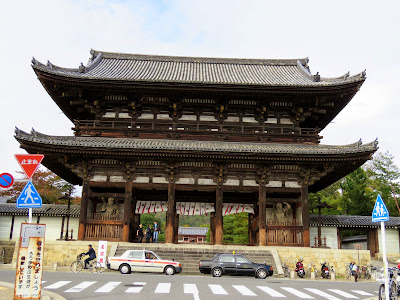
Ninna-ji Temple that has close relationship with imperial members for generations is situated at north west of Kyoto City. The establishment dates back to 9th century when Emperor Koko initiated and ordered to build a temple in year 886 for the purpose of blessing the nation and propagate Buddhist teachings but he died before it was done. The construction of Temple was completed in year 888 by his 3rd son Emperor Uda (1267-1324) who named the temple as Ninnaji after the reign title of his late father. Ninnaji is one of the great temples in Kyoto that listed as a historical monuments of the ancient city as well as an Unesco World Heritage site in 1994.


The double layers Niomon front gate measured at a height of 18.7 meters was restored in year 1637. It is one of the three important and famous temple gates in Kyoto. The decorative imperial styled Chokushi-mon entrance gate towards the left side of Niomon was opened to the South Garden of the head priest's imperial residence. The gate was used only by emperor's messengers or palace envoy. In year 1887, Chokushi-mon was destroyed by fire. The present structure was restored in year 1913.


Ninna-ji temple complex suffered from wars and fires that ravaged Kyoto through out the history. None of the buildings founded in 9th century was survived. All original buildings after destroyed by fire in Onin War (1467-77) were restored 150 years later with imperial support and funding. The oldest structures including its Niormon front gate, Chuman Inner Gate, 5-storeys Pagoda and Kondo Main Shrine were all dated back to early 1600s.



The simple Chumon Inner Gate with two fierce guardians on left and right was also one of the important cultural properties. Many other artifacts are now kept in the Lingbao-guan (灵宝馆) exhibition hall on the right grounds of the central walkway.



The central passage way from Chumon Gate leads to Hills of temple guarding site known as Qielan-Shan (伽蓝山) where many historical buildings are located. The reputable Kannon Hall that lies on the left grounds just opposite the red maple trees was closed for public. It enshrines in its hall, an image of thousand hands Kannon (Goddess of Mercy) with two Dharma Protectors by its left and right side, surrounded by 28 deities figures. The hall also houses many Buddhist traditional musical instruments and other images. The paintings of Buddhist images behind the altar, on the walls and pillars are particularly important and valuable. Kannon Hall until today still serve as a venue for Buddhist ceremonies.



Kondo Main Shrine stands immediately after a flight of stone steps directing facing to the central passage way.


The graceful golden lacquered Kondo Golden Hall was twice on fire. The present building was the former Shishin-den throne hall moved from imperial palace. It was restored within years 1624-1643 with roof changed to tiles instead of using the original tree bark skin. The Hall enshrines a golden image of Amitabha Buddha which is a national treasure of Japan.


The grounds of temple guarding Qielan-shan hills comprise a large courtyard with old buildings.



Ninna-ji Temple site is less touristic and less crowded with people. The picture of a modern Japanese young couple immersing in the 1100 years old heritage site, admiring the ancient structure and its accessories, was such a wonderful scene.



The oldest buildings that rebuilt during 16th to 17th century include a Scripture House and a Bell Tower which was an outstanding example of Edo architecture. Scripture House that was designed into a tradition Buddhist Zen style, is said to hold 768 cartons of Buddhist scriptures at its central octagonal rotating book rack with 96 boxes each.


Founders hall was built next to the bell tower. It houses images of Emperor Eda, the founder of Temple Ninna-ji and master Kukai (Kobo Daishi 774-835) the founder of Japanese Shingon Buddhism. Hills behind the temple is the Shikoku Hachiju Haka-sho 88 Temple pilgrimages.



The violet maple leaves are rare!





The two old structures of little shrine halls setting further down from the five storey Pagoda are also considered as part of the national cultural properties. Japan Deity images are housed inside the hall.



The 5 storey Pagoda that was restored in year 1644 has a height of 36.18 meter. It is a remarkable symbolic structure from the era.



The structure of Pagoda is rare and unique as it was built with very less difference in width from the base floor to top layer.



The massive Pagoda was supported by a main Shin-bashira pillar at center with four Tenchu pillars surrounded. The pillars and walls are decorated with paintings of Buddhist images with eight deities of Shingon Hasso.



Ninnaji Temple belongs to Shingon Sect of Japan Buddhism, which is a lineage of Mahayana belief.



The symbolic sign of Buddha Dainichi Nyorai was painted on a framed tablet at base floor and its image and other Buddha images are enshrined in the hall.



To have a brief understanding about the 5-storey Pagoda, read the description while you move towards a moss garden.



The Royal Temple is famous for a grove of its ancient dwarf cherries called Omuro that only begin to blossom in mid April, about 10-14 days later then the normal cherry flowers blooming period.


It was recorded that the 200 trees of Omuro Sakura had been in the precinct since early Edo period (1615-1868).




No comments:
Post a Comment